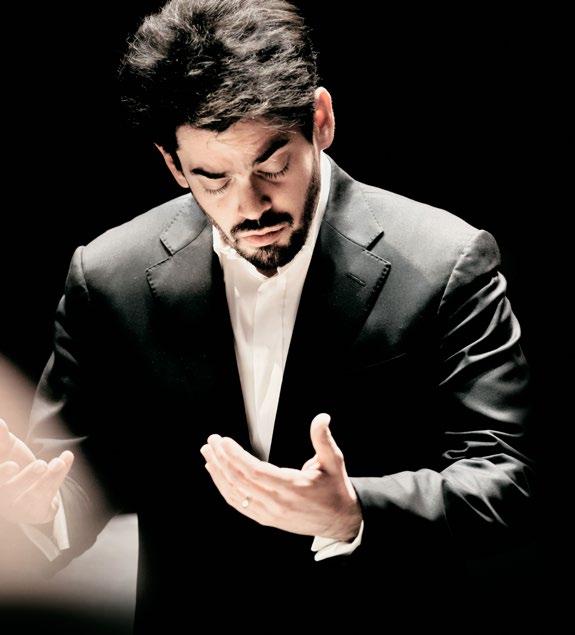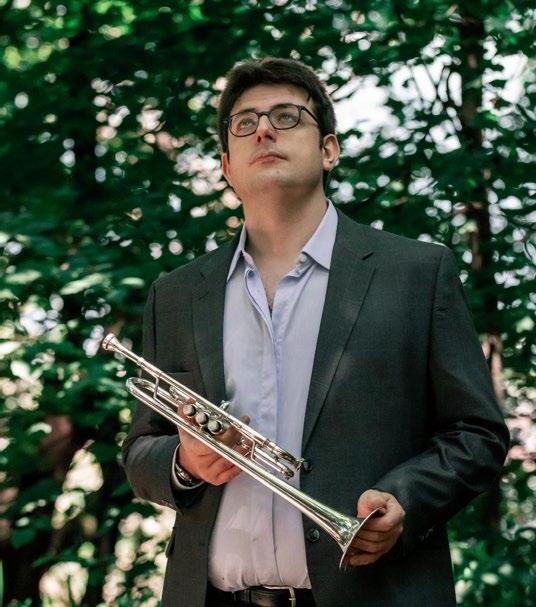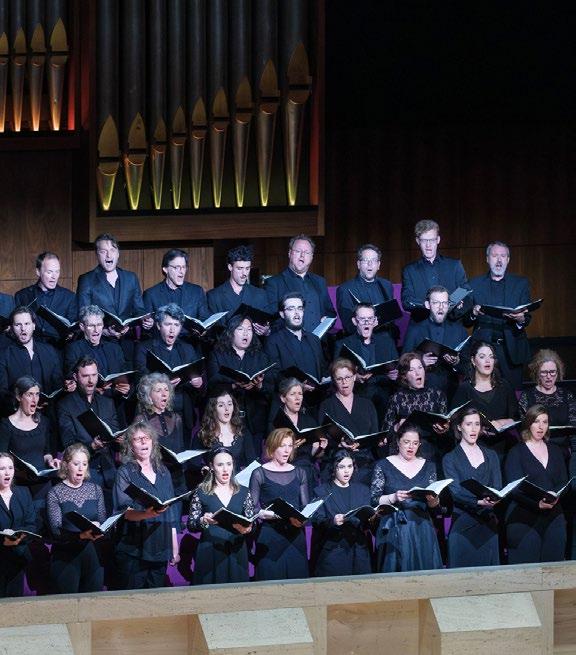




conductor Lahav Shani
piano Martha Argerich
trumpet Alex Elia
chorus Laurens Symfonisch
Henry Balfour Gardiner (1877-1950)
Evening Hymn (1908), orch. Lahav Shani
Igor Stravinsky (1882-1971)
Symphony of Psalms (1930)

• I (Psalm 38:13-14)
• II (Psalm 39:1–4)
• III (Psalm 150)
Dmitri Shostakovich (1906-1975)
Piano Concerto no. 1, op. 35 (1933)
• Allegretto
• Lento • Moderato
• Allegro con brio
intermission
Sergei Prokofiev (1891-1953)
Suite from Romeo and Juliet (1935/1940):
• Montagues and Capulets (The Prince Gives His Order – Dance of the Knights)
• Juliet as a Young Girl
• Scene (The Street Awakens)
• Dance (Dance of the Five Couples)
• Masks
• Romeo and Juliet (Balcony Scene –Love Dance)
• Tybalt’s Death
• Dance of the Antilles Girls
• Romeo and Juliet Before Parting
• Romeo at Juliet’s Tomb
Concert ends at around 22.45
Most recent performances by our orchestra: Gardiner Evening Hymn: first performance
Stravinsky Symphony of Psalms: Oct 2013, chorus Collegium Vocale Gent, conductor
Philippe Herreweghe
Shostakovich Piano Concerto no. 1: Feb
2008, piano Simon Trpceski, trumpet André Heuvelman, conductor Alan Buribayev
Prokofiev Romeo and Juliet: Dec 2017, conductor Gustavo Gimeno
One hour before the start of the concert, Bart de Graaf will give an introduction (in Dutch) to the programme, admission €5. Tickets are available at the hall, payment by debit card. The introduction is free for Vrienden.
Cover: Photo Stephen Hocking (Unsplash).Igor Stravinsky, Dmitri Shostakovich, and Sergei Prokofiev are often mentioned in the same breath as the three Great Russian composers of 20th century music. There is a lot to be said for this claim, but they never formed a trinity: they were each far too idiosyncratic to be lumped together like that. The differences between Stravinsky’s Symphony of Psalms, Shostakovich’s Piano Concerto No. 1 and Prokofiev’s Romeo and Juliet are therefore greater than their similarities – so great, in fact, that the Evening Hymn by British composer Henry Balfour Gardiner is perhaps not even the odd one out in this programme.
In the end, some composers are remembered only for one piece of music. An unfortunate fate, but British late-romantic composer Balfour Gardiner brought it upon himself. He was an industrious composer – two symphonies had been well received at the time – but he threw so much away that little remained. Evening Hymn is one of the rare survivors. It is a sacred song, based on the old Latin hymn Te lucis ante terminum (´To Thee, before the close of the day´). However, for Balfour Gardiner the work stood closer to the old English tradition of choral song than to religion; the work was written years after the composer had parted ways with his religious faith. The lush harmonies of the eight-part choir ensured its place as an evergreen in the English choral repertoire.
 Dmitri Shostakovich as soloist in his Piano Concerto no. 1, Moscow, late 1930s.
Dmitri Shostakovich as soloist in his Piano Concerto no. 1, Moscow, late 1930s.
Religious music need not always stem from a religious faith. There are various examples of this, such as the Requiem by Fauré (written ‘purely for pleasure’, according to the composer). A grey area is the Symphony of Psalms by Stravinsky, whose recent return to the fold of the Orthodox Faith was only part of the reason behind the composition

For some time already he had been delving into the polyphonic music of the old masters and wanted to write a choral work. When in 1929 he received a commission from conductor Serge Koussevitzky and the Boston Symphony Orchestra, he saw a clear opportunity.
In the Symphony of Psalms you can clearly hear the enthusiasm with which Stravinsky imbued his fundamental craftsmanship. The notes are tightly arranged and devoid of sentimentality, yet sound inspired – partly through the text that focuses on hope and redemption.
As its title indicates, the work was written for the concert hall and not for the church. Yes, they are psalms, but it is the symphonic setting that is more important. The term ´symphonic´ should be interpreted literally here, as ‘sounding together’, since in terms of its compositional form the Symphony of Psalms is entirely detached from the classical symphony as we know it from Haydn, Beethoven and Brahms. Stravinsky was returning to older, pre-classical principles. Inspired by earlier composers such as Palestrina and Bach, he focused on the contrast between high and low, light and dark, heavenly and earthly, vocal and instrumental. In this work, Stravinsky contrasts choral voices against an instrumental ensemble in which he has dispensed with clarinets, violins and violas. The texts come from the Old Testament Book of Psalms – the first half of the Bible in which God is still as bountiful with his punishments as he is with his blessings. Stravinsky accentuates the roughness of the texts with often grim harmonies. Despair reigns for the first two movements of the work: the composer chooses to make the choir and orchestra sound abrasive. But in the third movement the emotional temperature increases. The warmth with which the word ´Alleluia´ is characterised has no precedent in the preceding two movements. But Stravinsky does not let the work overheat; it ends in serene stillness.
David thanks God for being saved from Hell. Illumination by the Limbourg Brothers (c. 1412) of Psalm 39 in Les Très Riches Heures du duc de Berry. Coll. Musée Condé, Chantilly.The exuberance of Shostakovich´s Piano Concerto No. 1 is at odds with the anguished tone of his celebrated symphonies and string quartets. His body of work documented his long, difficult struggle with the creative restrictions with which the Soviet Union shackled its artists; it produced a lot of tragic-sounding music. However, at the time of this early piano concerto, the composer was more or less free to go about his business. He received praise for the originality of his composition and his performances as a concert pianist, and a blind eye was turned to his flirtation with jazz and variety theatre influences. He discovered such Western influences during his part-time jobs: the young Shostakovich played piano in cabaret clubs and accompanied silent films in the cinemas. This kind of entertainment music would always remain one of his frames of reference. Even his bruising Soviet symphonies, with their hysterical-joyful outbursts, are full of such influences. The Piano Concerto no. 1 is inclined towards circus music in places, partly characterised by a capricious solo trumpet. In fact, the original plan had been to write a trumpet concerto, but the idea evolved into a double concerto in which the piano ultimately took centre stage. Furthermore, due to the high content of ra-ta-ta-tat rhythms, it is easy to overlook the various references to the classical masters hidden in the music. Right at the start, the piano plays the opening motif of Beethoven’s Appassionata; there are references later in the work to composers such as Rossini and Haydn.
Initially, Prokofiev remained free of the Soviet doctrines that would have a vice-like grip on Shostakovich. Prokofiev would spend a large part of his life up to the age of forty-five in the free West, where his bitingly modernist compositions made a great impression. However, as time went on, he became tormented by homesickness, and
in 1936 he was lured back to the USSR. Then the trap snapped shut: the freedoms and privileges promised him failed to materialise, and to survive he was forced to adopt the mandatory, bombastic Soviet style.
Shortly after his ´homecoming´ he wrote what would become an immensely popular ballet, Romeo and Juliet. The work would give birth to his later epic style, whilst at certain moments also staying close to the sharp, crackling sound of his earlier works. The original play by Shakespeare – a much-loved dramatist in Russia – is full of unpredictable characters who fitted perfectly with Prokofiev’s whimsical idiom.
Everyone knows the story: two young lovers are kept apart because their respective families are at each other’s throats. Various deaths ensue as a result. Prokofiev describes the tensions in an almost cubist manner, with sharp contours and intense colour sounds; he explicitly rejects any soft focus. A perfect example of this can be heard right at the start of the suite being performed in this programme. The rival families are introduced with wrenching, threatening sounds and a dark dance. By contrast, the appearance of the teenage Juliet is signalled by a crystal-clear C-major key. There follow a number of almost character dances – including one by West Indian slave girls owned by Juliet’s family – and the intense denouement is introduced by the high-octane duel in which Romeo kills his opponent Tybalt; not just a highpoint of the suite, but a peak in Prokofiev’s entire body of work.
Michiel CleijThe young Shostakovich played piano in cabaret clubs and accompanied silent films in the cinemas

Born: Tel Aviv, Israel
Current position: chief conductor
Rotterdam Philharmonic Orchestra; music director Israel Philharmonic Orchestra
Before: principal guest conductor Vienna Symphony Orchestra
Education: piano at the Buchmann-Mehta School of Music Tel Aviv; conducting and piano at the Academy of Music Hanns Eisler
Berlin; mentor: Daniel Barenboim
Breakthrough: 2013, after winning the Gustav Mahler International Conducting
Competition in Bamberg
Subsequently: Staatskapelle Berlin, Berlin State Opera, Vienna Philharmonic Orchestra, Bavarian Radio Symphony Orchestra, Staatskapelle Dresden, Zurich
Tonhalle Orchestra, Berlin Radio Symphony Orchestra, Philharmonia Orchestra, Philadelphia Orchestra, Pittsburgh Symphony Orchestra, Seoul Philharmonic Orchestra, Royal Concertgebouw Orchestra
Debut Rotterdam Philharmonic: 2016
Born: Buenos Aires, Argentina
Education: with Friedrich Gulda in Austria; Arturo Benedetti Michelangeli, Stefan
Askenase
Awards: Geneva International Music Competition (1957); Ferruccio Busoni
International Piano Competition Bolzano (1957); Praemium Imperiale Award (2005), Kennedy Center Honor (2016)
Breakthrough: 1965, after winning the Fryderyk Chopin International Piano Competition Warsaw
Subsequently: soloist with all major orchestras in the world
Chamber Music: with pianists Stephen Kovacevich, Alexandre Rabinovich, the late Nelson Freire and Nicolas Economou, violinist Gidon Kremer, cellist Mischa Maisky
Festival: honorary president International Piano Academy Lake Como
Documentary: Martha Argerich –Evening Talk 2002
Debut Rotterdam Philharmonic: 1969
 Photo: Eduardus Lee
Photo: Caroline Doutre
Photo: Eduardus Lee
Photo: Caroline Doutre
Born: Chambave, Italy
Education: bachelor and master at the Conservatoire de la Vallée d’Aoste (Aosta) with Davide Sanson, further study at the Buchmann-Metha School of Music (Tel Aviv)
Awards: Aeolus International Competition for Wind Instruments, Düsseldorf (2013), 25th International City of Porcia Competition (2014)
Career: freelance trumpet player; principal trumpet at the Rotterdam Philharmonic Orchestra since 2018

Chamber Music: Trio all’Opera, with Lorenzo Passerini (trombone) and Marco Cadario (organ)
Solo Appearances: Filarmonica di Milano, Orchestra Antonio Vivaldi, ensemble of the Accademia Nazionale di Santa Cecilia, various international music festivals
As a Teacher: Masterclasses, e.g. at I FIATI, at the Aosta Conservatory and at the international IMMF Festival
Founded: 2013, in consultation with de Doelen and the Rotterdam Philharmonic Orchestra
Conductor: Wiecher Mandemaker
Repertoire: choral symphonic repertoire

Debut: 2013 with Brahms’ A German Requiem
Co-operations: Royal Concertgebouw Orchestra (Tan Dun: Requiem for Nature (world premiere), Honegger: Jeanne d’Arc au bûcher – the recording, released as super audio cd under the RCO Live label, won the International Classical Music Award), BBC Symphony Orchestra (Howells: Hymnus Paradisi), BBC Scottish Symphony Orchestra (Britten: Ballad of Heroes), Residentie Orkest (Verdi: Requiem), Orchestra of the Eighteenth Century (Beethoven: Symphony no. 9, Fidelio)
Debut Rotterdam Philharmonic: 2014
Photo: Irene Valentini Photo: Jan HordijkFri 13 October 2023 • 20.15
conductor Finnegan Downie Dear violin Clara-Jumi Kang
Adès The Exterminating Angel Symphony
Britten Violin Concerto
Mussorgsky Pictures at an Exhibition
Music for Breakfast 1
Sun 29 October 2023 • 10.30
Jurriaanse Zaal, de Doelen with Karel Schoofs (oboe) and colleagues from the orchestra
Blake Suite for two oboes and cor anglais
Bozza Bergers de Provence
Britten Pan (from: Metamorphoses)
Canteloube Rustiques
Covoni Pandemonio
Fri 3 November 2023 • 20.15
Sun 5 November 2023 • 14.15
conductor Tarmo Peltokoski
piano Yuja Wang
Bartók Romanian Folk Dances
Bartók Piano Concerto No. 2
Strauss Also sprach Zarathustra
Thu 9 November 2023 • 20.15
Fri 10 November 2023 • 20.15
Sun 12 November 2023 • 14.15
conductor Maxim Emelyanychev
piano Beatrice Rana
Rachmaninoff Piano Concerto No. 2
Tchaikovsky Symphony No. 4
Chief Conductor
Lahav Shani
Honorary Conductor
Yannick Nézet-Séguin
Principal Guest Conductor
Tarmo Peltokoski
First Violin
Marieke Blankestijn, concertmeester
Quirine Scheffers
Hed Yaron Meyerson
Saskia Otto
Arno Bons
Mireille van der Wart
Rachel Browne
Maria Dingjan
Marie-José Schrijner
Noëmi Bodden
Petra Visser
Sophia Torrenga
Hadewijch Hofland
Annerien Stuker
Alexandra van Beveren
Second Violin
Charlotte Potgieter
Cecilia Ziano
Frank de Groot
Laurens van Vliet
Tomoko Hara
Elina Staphorsius
Jun Yi Dou
Bob Bruyn
Eefje Habraken
Maija Reinikainen
Wim Ruitenbeek
Babette van den Berg
Melanie Broers
Lana Trimmer
Viola
Anne Huser
Roman Spitzer
Galahad Samson
José Moura Nunes
Kerstin Bonk
Lex Prummel
Janine Baller
Francis Saunders
Veronika Lénártová
Rosalinde Kluck
León van den Berg
Olfje van der Klein
Cello
Emanuele Silvestri
Eugene Lifschitz
Joanna Pachucka
Daniel Petrovitsch
Mario Rio
Gé van Leeuwen
Eelco Beinema
Carla Schrijner
Pepijn Meeuws
Yi-Ting Fang
Double Bass
Matthew Midgley
Ying Lai Green
Jonathan Focquaert
Robert Franenberg
Harke Wiersma
Arjen Leendertz
Ricardo Neto
Flute
Juliette Hurel
Joséphine Olech
Désirée Woudenberg
Flute/piccolo
Beatriz Da Baião
oboe
Remco de Vries
Karel Schoofs
Anja van der Maten
Oboe/Cor Anglais
Ron Tijhuis
Clarinet
Julien Hervé
Bruno Bonansea
Clarinet/ Bass Clarinet
Romke-Jan Wijmenga
Bassoon
Pieter Nuytten
Lola Descours
Marianne Prommel
Bassoon/ Contrabassoon
Hans Wisse
Horn
David Fernández Alonso
Felipe Santos Freitas Silva
Wendy Leliveld
Richard Speetjens
Laurens Otto
Pierre Buizer
Trumpet
Alex Elia
Simon Wierenga
Jos Verspagen
Trombone
Pierre Volders
Alexander Verbeek
Remko de Jager
Bass trombone
Rommert Groenhof
Tuba
Hendrik-Jan Renes
Percussion
Danny van de Wal
Ronald Ent
Martijn Boom
Adriaan Feyaerts
Harp
Charlotte Sprenkels